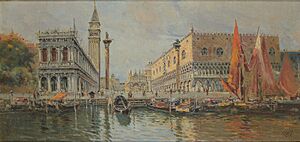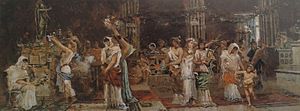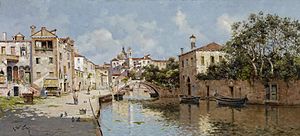Antonio María Reyna Manescau facts for kids
Quick facts for kids
Antonio María Reyna Manescau
|
|
|---|---|
 |
|
| Born | 5 December 1859 Coín, Málaga, Spain
|
| Died | 3 February 1937 Rome, Italy
|
| Nationality | Spanish |
| Education | Málaga School of Fine Arts |
| Known for | Painting |
Antonio María Reyna Manescau (born December 5, 1859 – died February 3, 1937) was a famous Spanish painter. He spent most of his life and career in Italy.
Antonio was part of the Málaga School of Painting. He learned from great teachers like Bernardo Ferrándiz. He also studied with José Moreno Carbonero, who became another master painter.
When he was in his early 20s, he moved to Italy. There, he was inspired by other artists. He lived in Italy for the rest of his life.
After visiting Venice in 1885, he started painting many landscapes. He became very well-known for his detailed paintings of Venice. These paintings, called vedutas, showed buildings and canals. He was a master at using colors. Some of his most famous works show the Venetian canals and Piazza San Marco. He also painted Floralia and Rancho Andaluz.
Early Life and Learning
Antonio was born in the town of Coín in Málaga, Spain. He was one of ten children. Even as a young boy, Antonio was very good at drawing.
He started his art training in Málaga. He went to the School of Fine Arts. His teachers included Joaquín Martínez de la Vega and Bernardo Ferrándiz. Ferrándiz was the founder of the Málaga School of Painting.
Antonio studied alongside José Moreno Carbonero. Moreno Carbonero was only a year older than him. From a young age, Antonio showed his art often. People noticed his bright colors and clever designs. He was also very quick with his paintbrush. In 1880, when he was 20, he sold his first important painting. The town hall of Coín bought it.
His Painting Career
In 1882, Antonio received a special scholarship. This money helped him study art in Italy. He moved to Rome, where he lived until he passed away.
In 1885, he visited Venice for the first time. From then on, Venice became a big part of his art. He painted famous places like the Grand Canal and Piazza San Marco. He also painted less known parts of the city.
Venice was a popular place for Spanish painters. Many artists were inspired by the city's beauty. Antonio learned from other painters there, like Villegas Cordero and Martín Rico. He copied their style of painting very detailed landscapes.
Antonio was supposed to finish his scholarship in 1886. But he loved Italy so much that he stayed. In Rome, he often visited the art studio of Villegas Cordero. Many other Spanish artists did the same.
In 1889, he married Beatriz Mililotti Desantis, an opera singer. They made their home in Rome.
Around the mid-1880s, Antonio painted his famous work Floralia. This painting showed a classical scene. It was about an old festival for the goddess Flora and the start of spring. To make it very accurate, he traveled to southern Italy. He studied ancient wall paintings and mosaics.
In 1887, he sent Floralia from Rome to Madrid. It was shown at the National Exhibition of Fine Arts. The painting won a medal and made him famous in Spain. The Spanish government bought the painting. Sadly, it disappeared during the Spanish Civil War. Today, we only know this work from old pictures and a smaller sketch.
By 1895, Antonio was a well-known painter. He was invited to decorate the headquarters of the Ateneo de Madrid in Spain. While in Madrid, the King of Spain, Alfonso XIII, gave him a special award. It was the highest honor for a Spanish artist.
Antonio also showed his art in London. His Venetian paintings were very popular there. In Italy, his art was shown often in Rome. Three of his paintings, called Roma sparita, were bought by the fine arts museum in Rome.
As his fame grew, he painted two portraits of Pope Benedict XV. These paintings are now in the Vatican Museum. He traveled a lot in Italy, always showing his new art. He spent time in Assisi, visiting his friends, the Benlliure brothers. He also studied art in Naples.
Even though he painted many realistic scenes, he still loved Venice. He continued to paint its canals and views. On August 4, 1899, his only daughter, María Matilde, was born.
In 1910, Antonio's mother passed away. He traveled back to his hometown of Coín for her funeral. During this visit, he painted a large picture called Rancho Andaluz. It showed a family farm. He showed this painting at an art exhibition in Rome in 1911. Today, you can see Rancho Andaluz in the town hall of Coín.
Antonio Reyna Manescau's paintings are in many museums. These include the Boston Museum of Fine Arts, the Hermitage Museum, and the Carmen Thyssen Museum. His works are also in private collections.
Painting Style
Antonio Reyna Manescau mostly painted landscapes and city views. He focused a lot on the city of Venice. He was excellent at painting small, detailed urban scenes. He often painted the same views with only small changes.
His paintings are known for being very precise and detailed. He paid great attention to architectural details. He was very skilled at drawing and creating interesting compositions. His art also showed rich colors and bold brushstrokes.
Gallery
See also
 In Spanish: Antonio Reyna Manescau para niños
In Spanish: Antonio Reyna Manescau para niños















